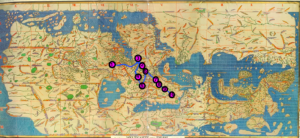Comparison between the medieval map, the Tabula Rogeriana, and the modern map, Google Maps, reveals the stark differences between the two maps that highlight the inaccuracies in the Tabula Rogeriana. The Tabula Rogeriana misinterprets much of the sizes of many bodies of water in and around the Eurasian continent. For example, on the Tabula Rogeriana, what I assuming to be the representation of the Black Sea is drawn to connect to a larger body of water that is connected to the ocean by a strait of water that goes through Northern Europe. On the Google Maps, there is no strait of water that goes through the top of the continent, though there is an ocean above the entire continent. The Black Sea does not connect to the ocean above Europe, thus revealing that travelers during this time period had yet to travel to the Northern areas of Eastern Europe and Asia and assumed the region to be just water. In addition to the areas travelers mainly had yet to venture to, most of the Mongol region in this medieval map is depicted as large bodies of water, revealing another region that most travelers had not yet reached or been able to explore and did not know of his existence. Given the Mongol region seems to be mainly untouched by other travelers, Polo presumably thought he had traveled into most of Asia because the borders of the Mongol Empire align with the Tabula Rogeriana’s drawn ending of the continent. However, though the sizes are inaccurate, the general locations of the bodies of water in the Middle East are fairly accurate. Though farther West and East the bodies of water tend to represent regions that have yet to be traveled to by Western travelers, such as Marco Polo.
Another difference worthy of note between the two maps is the drawing of the Eurasian continent. The shape of the mainland and those islands scattered within the other bodies of water within the continent on the medieval map do not match that of the modern map. The Tabula Rogeriana’s western region beyond the particular route of Marco Polo in this map excludes all of Africa and its drawing of Europe does not match the modern map’s Europe. Europe on the modern map is drawn in the shape of a dragon head with smaller regions underneath and long stretches that reach the area of this particular travel of Polo’s. The medieval map’s western region, immediately west of Polo’s depicted route, shows the shape of Spain’s country, which matches that of the modern map. Essentially, using the modern map as a template, the medieval map depicts Spain as the entire shape of the European continent which then feeds immediately into the Middle East, the location of Polo’s route. The end of Polo’s route exemplifies where medieval travelers knew to be the edges of Asia, which upon reviewing the modern map, was the center of the Middle East. Further, it seems medieval travelers assumed the Middle East was significantly closer to Europe than it was. The regions that are assumably Europe and the Middle East are drawn to be very close to each other with not much region in between, also suggesting they did also did not know the actual size of Europe as all of the modern map’s Northern Europe is not pictured on the medieval map.

